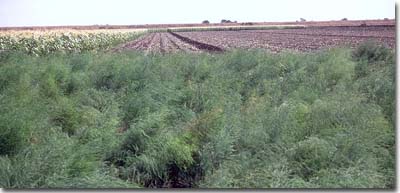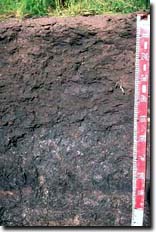Victorian State Soil Contender - Black Vertosol

Back to: Contenders for State Soil
Why should the Black Vertosol be Victoria’s State Soil?
- The cracks that form on this soil are world famous, as this ‘Merri Creek’ soil has been used for the MCG cricket pitch. The distinct characteristics of the Black Vertosol have led to issues such as patchy or poor grass growth, variability in the ball bounce and uneven wear. Soil for the MCG pitch has historically been obtained from the Merri Creek floodplain to the west of Melbourne.
- Black Vertosols occur on basalt plains areas in the western Port Phillip as well as Corangamite regions. They also occur on the former extensive 'Koo-Wee-Rup swamp'. In the Koo-Wee-Rup region these soils have developed on swamp deposits and are highly valued for cropping (particularly potatoes and asparagus - much of which is exported to Japan). In the Koo-Wee-Rup region these soils often have a peaty layer at depth. On the Bellarine Peninsula, wine is also produced on these soils.
- The Queenslanders have pipped us to the post and selected the Vertosol as their State Soil. This is fair enough as Queensland has extensive areas of Black Vertosols that are very productive for that state.

Asparagus cropping on Black Vertosol near Dalmore.
Key features of the Black Vertosol
- These soils are clayey throughout - with at least 35% clay in the surface horizon. If you walk on them when they are wet you will certainly get 'clay feet'.
- Vertosols have high shrink-swell properties that give rise to some interesting features such as 'slickensides' and other vertic features such as 'lenticular' structure. The shrinking and swelling that occurs during wetting and drying cycles is often so extreme that it causes the ground surface to rise. The land surface is characterised by an uneven series of mounds and hollows, referred to as 'gilgai'. Gilgai is a native Australian (Koori) term that is used internationally to describe this feature. The shrinking and swelling in these profiles can be responsible for disruption to fences and telephone poles as well as walls and foundations of buildings. Continuous cultivation of paddocks has resulted in the smoothing out of many of these formations. The forces that created them, however, are still operating as is evident by the displacement of fence posts, and if the land is left undisturbed for a number of wetting and drying seasons they will re-form. In areas with gilgai microrelief, crop and pasture growth is likely to be uneven across a paddock due to soil variations and poor drainage conditions in depressions.
- Because of their shrink-swell properties, Vertosols often have deep, wide cracks that open up when the soil is dry. These cracks often extend from the surface soil into the deeper subsoil.
- The surface condition of Vertosols can vary greatly and is an important determinant of its cropping potential. Surface soil can range from being hard and massive (structureless) to coarsely structured and to having many fine aggregates at the surface - known as 'self-mulching'. These fine aggregates provide a favourable 'bed' for plant germination and establishment. The fine aggregates can also fall down cracks and end up deep in the soil profile, this behaviour often being referred to as 'self-swallowing'
- Black Vertosols are characterised by clayey subsoil horizons that are black in colour. In situations where these soils have formed in former swamps, their dark colour can be attributed to organic matter.
| Typical soil profile This example Black Vertosol occurs in the Cardinia area near Cranbourne. It has formed on swamp deposits of what was formerly the extensive ‘Koo-Wee-Rup Swamp’ – which was drained in the late 1800s. Further information on the history of drainage of the Koo-Wee-Rup area can be found elsewhere on this website. |  Black Vertosol near Cardinia. | ||
| Surface Soil | |||
| A1 | 0-10 cm | Black; light medium clay; self-mulching surface; very strongly acid pH (pH 4.7) | |
| Subsoil | |||
| B21 | 10-30 cm | Black; medium clay; strongly acid pH (pH 5.0) | |
| B22 | 30-50 cm | Black; medium clay; very strongly acid pH (pH 4.7) | |
| B23 | 50-85 cm | Black; heavy clay; lenticular structure and slickensides; strongly acid (pH 5.3) | |
| B24 | 85-115 cm | Black; peaty clay; moderately acid pH (pH 5.9) | |
Other examples of Black Vertosols on the VRO website:
Black Vertosol near Dalmore in the Port Phillip and Westernport region


